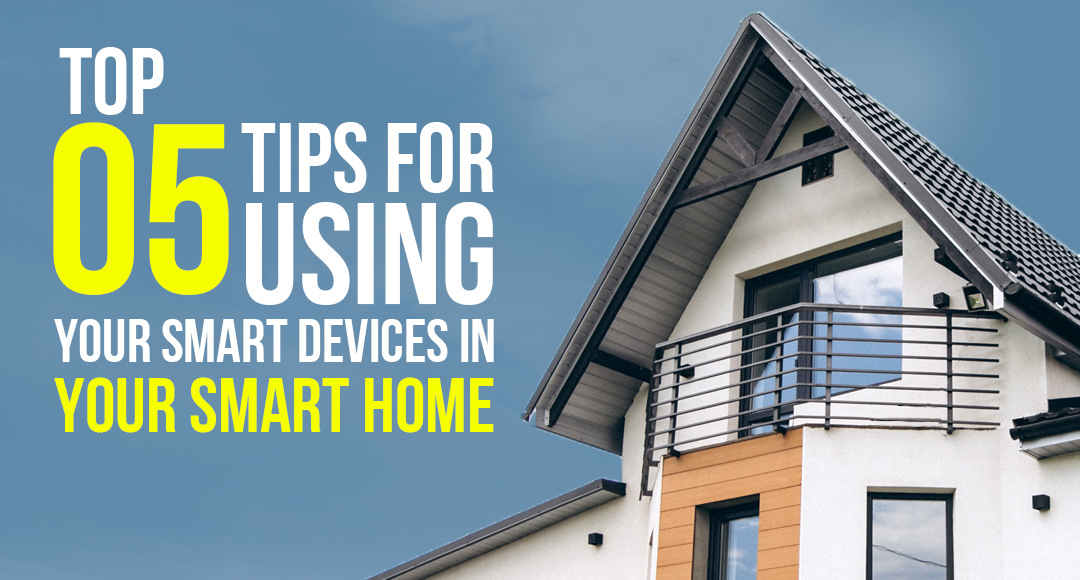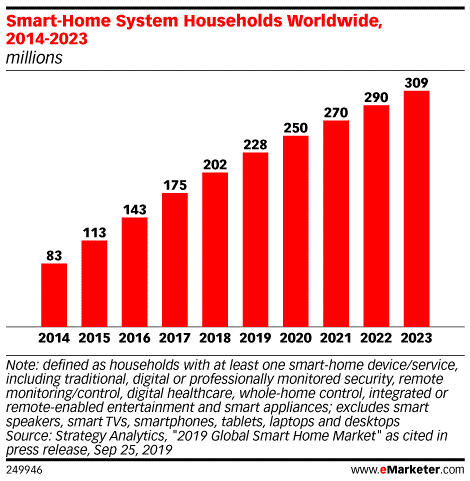Top 5 Tips for using your smart devices in your smart home

- Mar 24, 2021
- by Spikebot
Top 5 Tips for using your smart devices in your smart home
Who would have thought that we would be controlling the lighting and fan speed automatically or just with a voice command? Who would have thought that with specific devices, you can have the idea about humidity and temperature, too? But this all things are possible now, thanks to IoT home automation.
Look at the above stats; back in 2019 that, by 2020, there would be 270 million households with at least one smart-home device/service. Which will go as high as 300+ million by 2023. This is enough justification for the trend and demand for IoT based home automation.
According to a study, cyber-attacks on IoT devices rose by 300 percent in 2019. Cybercriminals enjoy the idea that they may ruin your existence by exploiting security bugs and weaknesses of items in our beloved home. So, when you adopt smart home automation using IoT – make sure to follow specific tips.
The smart home technology
The concept of a smart house is not entirely novel. You might not realise that innovative home technology has recently evolved and developed to the point where it will now impact almost any aspect of your home and how you communicate with it.
The majority of today’s inventions allow things more straightforward to work with your kitchen, toilet, lighting, and air temperature, rendering your house more energy-efficient, cosy, and capable than ever before. The most significant thing is that each of these developments is just getting stronger over time. In particular, many of them are modular enough to allow for potential updates, helping you get much more out of the device.
Top 5 Tips for using your smart devices while IoT home automation
Now, let’s dive into the top 5 exclusive tips without wasting much time, which would help you a lot.
1. Get yourself going with Multi-factor Authentication
Since you’ve already used online banking, you’re acquainted with multi-factor authentication. We generally call it as two-factor authentication. It is an additional encryption layer that goes beyond a simple password. With two-factor authentication, anybody trying to log in to your IoT system must have further proof of identification.
Your evidence may be a one-time pin (OTP) or an authentication code sent to your email and phone that proves the individual signing in is you? Most intelligent devices provide multi-factor authentication by design, although there are a few that do not. In that scenario, you can use third-party applications like Google Authenticator to allow 2FA. Check whether the IoT based home automation system has such a feature or not.
2. Use NGFW – Next-Generation Firewall
A next-generation firewall (NGFW) is a network platform that incorporates a standard firewall with other protection functions such as the ones described above. An NGFW has all of the conventional firewall features, rendering it highly effective at detecting and defending against cyber threats.
Next-generation firewalls are a costly investment, but the improved coverage for your smart home makes it worthwhile. After all, if you really can afford smart home automation using IoT, you can always afford to pay a bit more money to protect them. You are defending your identity by doing so.

3. Update your devices frequently.
In IoT based home automation, Firmware doesn’t get upgraded automatically. These upgrades also provide critical protection fixes that can highly improve the security of your devices and network.
Do a manual search every few months, and if there are any pending firmware patches, get them right away. Similarly, many IoT devices / IoT home automation (and their apps) do not immediately upgrade but still ask you to do so if an update is required. Again, don’t put off updating; instead, do so right away.
4. Disable those features which you are not using in routine
In smart home automation using IoT, Many IoT devices allow you to operate them anywhere on the globe. Disable remote control if you have them on your home Wi-Fi network. Intelligent speakers, too, provide Bluetooth compatibility in parallel to Wi-Fi. And if you don’t need it? Please turn it off.
Thus, removing functionality is more about preventing as many of those numerous entry points as possible.
5. Have the most robust password for IoT based home automation
Aside from your Wi-Fi router’s code, there are also other instant and case where you have to use a secure password. For example, to access your IoT devices, you must first build an account and sign in. The machines are typically linked to mobile applications where specific credentials are needed. If you are already into IoT home automation – check for this NOW!
It is now critical to establish specific passwords for and IoT device’s account and app. This is done such even if one device’s password is broken; the others stay unaffected.
Bottom Line
In the name of IoT home automation – you can go for an expensive product that fits into your pocket. But do not forget to consider these tips.
As a result, there has been a sufficient amount of conversation and knowledge of smart home automation protection using IoT. Whether you have unique intelligent home systems or are just getting started with the smart home philosophy, take advantage of our excellent services to protect your gadgets and gizmos.
We are always happy to assist you; please email us at [email protected].

